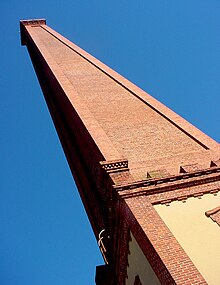Confederate Powderworks

The Confederate Powderworks (a.k.a. the Augusta Powderworks) was a gunpowder factory during the American Civil War. It is one of the only permanent structures completed by the Confederate States of America that wasn't destroyed by Union forces.[1] Colonel George Washington Rains chose the old United States Arsenal site between the Augusta Canal and Savannah River in Augusta, Georgia, as a secure inland location with good rail and water connections. The Powderworks produced almost 3 million pounds of gunpowder during the war.
History
[edit]George Washington Rains graduated from West Point with the class of 1842[2] and served as a chemistry teacher for the Military Academy. He had resigned to become president of an iron works in Newburgh, New York. At the start of the Civil War he chose allegiance to his native North Carolina and returned to the south. He was placed in charge of the Gunpowder and Niter Bureau by Jefferson Davis, the president of the Confederacy.[3]
Construction of the powder works began in September 1861, a 130 hp steam engine was purchased from an Atlanta flour mill owned by Richard Peters[4] and the powder works was producing gunpowder in just 7 months in 1862. Rains was guided by a pamphlet written by a British artillery officer describing the powder works at Waltham Abbey in Essex County near London, and also found someone who had worked there to advise him.[3]
As was customary for gunpowder mills, the buildings were separated and designed to survive explosions, with raw materials starting at one end, and the finished powder ending a mile and a half away at the other end. The saltpeter refinery building was the largest, was designed in Gothic style as a replica of the British Houses of Parliament.
The Confederate Powderworks was the second largest gunpowder factory in the world at that time, producing 3.5 tons per day. More than 2.75 million pounds of first-quality gunpowder (a majority of the powder used by the Confederacy) were produced before its closure in 1865.[5] By comparison, Union gunpowder manufacture was distributed among many mills, with the larger Hazard Powder Company of Connecticut producing 40% of the annual production of 8.4 million pounds.[6]

Historian and publisher Theodore P. Savas of Savas Beatie is finishing what promises to be a definitive biography of George W. Rains, the powder works, and Confederate logistics. It will include an in-depth examination of his early years, his extensive Mexican War service, interwar years, a detailed discussion of his role during the Civil War based extensively on primary and heretofore unused documents, and his postwar life.
Remains
[edit]Although the massive works were seized and dismantled after the war ended, Rains asked in 1872 that the obelisk chimney be spared as he had designed it to "... remain a monument to the Confederacy should the Powderworks pass away". On June 2, 1879, Augusta gave custody of the chimney to the Confederate Survivors Association to "beautify it and protect it from injury as a Confederate Memorial". The association repaired the square castellated base, protected the corners and in the face, looking towards the canal inserted a large tablet of Italian marble, bearing this inscription: "This Obelisk Chimney — sole remnant of the extensive Powder Works here erected under the auspices of the Confederate Government — is by the Confederate Survivors' Association of Augusta, with the consent of the City Council, conserved in Honor of a fallen Nation, and inscribed to the memory of those who died in the Southern Armies during the War Between the States".
The 150 foot tall chimney still stands on the Augusta Canal and is one of the more recognizable features of the Augusta skyline today, located at the Sibley Mill at 1717 Goodrich Street in Augusta. The Sibley cotton mill was built on the site as a private venture in 1880–82, using bricks from the demolished powder works, and became one of the largest and most successful cotton mills in the region.[5] It manufactured denim until 2006, and the mill's water-driven turbines still generate electricity which is sold to Georgia Power.
The chimney is the only remaining portion of the original powder works. The B/G E. Porter Alexander Camp #158, Sons of Confederate Veterans, spent eight years raising $192,000 to restore the chimney with its historical marker; work started on November 19, 2009, and was completed on March 12, 2010. A rededication ceremony was held on Oct. 9, 2010.[7]
References
[edit]- ^ Bragg, C. L. (2001) "The Augusta powder works: The Confederacy's manufacturing triumph", American Rifleman 149(5), pp 58.
- ^ Miller, Francis Trevelyan (1957). The Photographic History of The Civil War. Vol. Five: Forts and Artillery. New York: Castle Books. p. 162.
- ^ a b Kelly, Jack (2004). Gunpowder; Alchemy, Bombards, & Pyrotechnics ... Basic Books.
- ^ Shingleton, Royce, Richard Peters (1985), p.82
- ^ a b Sibley Mill and Confederate Powder Works Chimney-Augusta: National Park Service
- ^ Miller, Francis Trevelyan (1957). The Photographic History of The Civil War. Vol. Five: Forts and Artillery. New York: Castle Books. p. 143.
- ^ "Historic Augusta News, Summer/Fall 2011" (PDF). 2011. p. 20.
- Confederate States of America monuments and memorials in Georgia
- Manufacturing plants in the United States
- Georgia (U.S. state) in the American Civil War
- 1861 establishments in the Confederate States of America
- 1865 disestablishments in the Confederate States of America
- Landmarks in Georgia (U.S. state)
- Buildings and structures in Augusta, Georgia
- Tourist attractions in Augusta, Georgia
- Military installations in Georgia (U.S. state)
- Augusta Canal National Heritage Area
- Gunpowder mills
